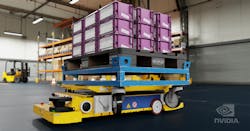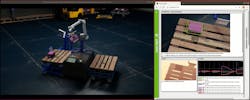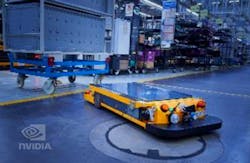BMW Outfits Robots with Artificial Intelligence
Building cars at BMW involves the handling of millions of parts flowing into a factory from more than 4,500 supplier sites. One factor increasing the factory logistics challenge for the BMW Group is the customizability offered by the company. With an average of 100 different options available, this translates into 99% of customer orders being unique to each customer.
“Ultimately, the sheer volume of possible configurations became a challenge to BMW Group production in three fundamental areas—computing, logistics planning, and data analysis,” said Jürgen Maidl, senior vice president of logistics for the BMW Group.
According to Nvidia, its Isaac software development kit provides these robots with neural networks capable of “addressing perception, segmentation, and human pose estimation to perceive their environment, detect objects, navigate autonomously and move objects. These robots are trained both on real and synthetic data using Nvidia graphics processing units (GPUs) to render ray-traced machine parts in a variety of lighting and occlusion conditions to augment real data.”
He said that, after delivery to the plant, parts are transported to the assembly line in containers of various sizes. Stationary SplitBots take full plastic boxes from the pallet in the incoming goods area and place them on a conveyor system that transports the boxes to a warehouse. The SplitBot also makes sure the containers are lined up correctly for automated storage. Using Nvidia’s artificial intelligence (AI), the SplitBot can detect and process up to 450 different containers.
Mobile PlaceBots unload tugger trains and place boxes loaded with goods on a shelf. These robots use Nvidia’s image recognition system to classify the small load carriers and determine the ideal grip point from the combined input of sensors, cameras, and artificial intelligence. These technologies allow the PlaceBots to move autonomously in a predetermined area.
Another logistics robot, the PickBot has a robotic arm that it uses to collect various small parts from supply racks. Like the SplitBots, the PickBot uses Nvidia’s AI technology to calculate the right grip point.
The robotic manipulation arm of the SortBot takes empty boxes and puts them on a palette to be sent back to the supplier area. These SortBots are deployed in series production to stack empty containers on pallets before they re-enter circulation.
BMW’s autonomous Smart Transport Robots (STRs) can identify obstacles such as forklift trucks, as well as humans, to more accurately and quickly suggest alternative routes as needed. They can also learn from the environment and apply different responses to people and objects.
Huber noted that all of these robots have been developed by BMW in the past five years, with most being deployed and tested in BMW factories since 2019. “The robots are trialed during our development process at various BMW plants in Germany, as well as at our logistics laboratory in Munich,” he explained.
The STR was developed by BMW’s logistics innovation team together with Fraunhofer Institute Dortmund,” Huber added.
Nvidia notes that the real and synthetic data generated during the testing of these robots are used to train deep neural networks on Nvidia’s DGX AI infrastructure development systems. The robots are then continuously tested in Nvidia’s Isaac Sim simulators for navigation and manipulation development, operating on Nvidia’s Omniverse platform, where multiple BMW Group personnel in different geographies can all work in one simulated environment.
Huber said that, incorporating Nvidia’s AI technology into BMW’s robots allows BMW to “optimize our robotics and material flow, as well as take simulations in the planning process to a new level.”
About the Author
David Greenfield, editor in chief
Editor in Chief

Leaders relevant to this article:



